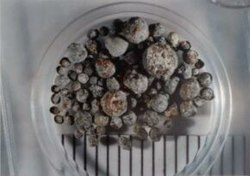Chondrules

Chondrules (χόνδρος Greek, Chondros , grain), also Chondrulen called millimeter-sized are silicate beads that in a fine grained matrix are embedded. They occur in undifferentiated meteorites , which are also called chondrites . These can contain up to 80% chondrules.
Chondras were described as curios globules as early as 1802 by Jacques Louis de Bournon (1751-1825) . The name "Chondre" was introduced in 1869 by Gustav Rose at the Mineralogical Museum of the Humboldt University in Berlin .
Emergence
Chondritic meteorites represent the oldest material in our solar system . It is believed that the other objects of the planetary system were ultimately formed from chondritic material. Because of the abundance of chondrules in this material, it is therefore important to understand their formation if one wants to understand the formation of the planetary system. It is now known that chondrules were formed from previous material that was heated very quickly - within minutes or even less - to temperatures of up to 1900 ° C and melted in the process . The molten globules then cooled down again within hours.
Due to the relatively short heating and cooling phases required, but not arbitrarily, some postulated development processes can be excluded :
- in the sun mist :
- hot areas inside
- FU Orionis phase of the early sun
- electrical discharges (flashes of fog)
- magnetic flares
- on protoplanets :
It is therefore currently assumed that the energy source for the formation of the chondrules was accretion shocks ( shock waves ) during the formation of the proto- gas planets .
classification
The chondrules can be divided into three classes according to their structure in the thin section ( porphyry , non-porphyry and granular structure), whereby the first two classes can be divided into three further subgroups each according to their mineral components:
| class | abbreviation | Components | Frequency [%] |
|---|---|---|---|
| porphyry | PO
PP POP |
Olivine
Olivine pyroxene |
23
10 48 |
| non-porphyry | RP
BO C. |
radial pyroxene
bar-shaped olivine cryptocrystalline |
7th
4th 5 |
| granular | GOP | granular olivine pyroxene | 3 |
literature
- Frank Wlotzka, Fritz Heide: Meteorites: Messengers from Space . Springer Verlag, 1995, ISBN 0-387-58105-7 .
- Roger H. Hewins, Rhian H. Jones, Eduard R. Scott (Eds.): Chondrules and the Protoplanetary Disk . Cambridge University Press, 1996, ISBN 0-521-55288-5 .
- N. Vogel: Chondrule formation and accretion processes in the early solar nebula - Clues from noble gases in different constituents of unequilibrated chondrites . Der Andere Verlag, Osnabrück 2004, ISBN 3-89959-055-4 .
- Günther Graup : Terrestrial chondrules, glass spherules and accretionary lapilli from the suevite, Ries crater, Germany ' . In: Earth and Planetary Science Letters . tape 55 . Amsterdam 1981.
Web links
- What are chondrules? from the alpha-Centauri television series(approx. 15 minutes). First broadcast on July 19, 2006.
- Christian Pinter: Enigmatic globules - The age-old “chondrules” cause headaches for researchers. ( Memento from April 14, 2011 in the Internet Archive ) Wiener Zeitung
Individual evidence
- ↑ What are chondrules? from the alpha-Centauri television series (approx. 15 minutes). First broadcast on July 19, 2006.
- ^ O. Richard Norton: The Cambridge Encyclopedia of Meteorites . Cambridge University Press, Cambridge 2002, ISBN 0-521-62143-7 , pp. 107 .
- ↑ James Gooding, Klaus Keil: Relative Abundances of Chondrule Primary Textural Types in Ordinary Chondrites and their Bearing on Conditions of Chondrule Formation . In: Meteoritics . tape 16 , 1981, pp. 17-43 .
